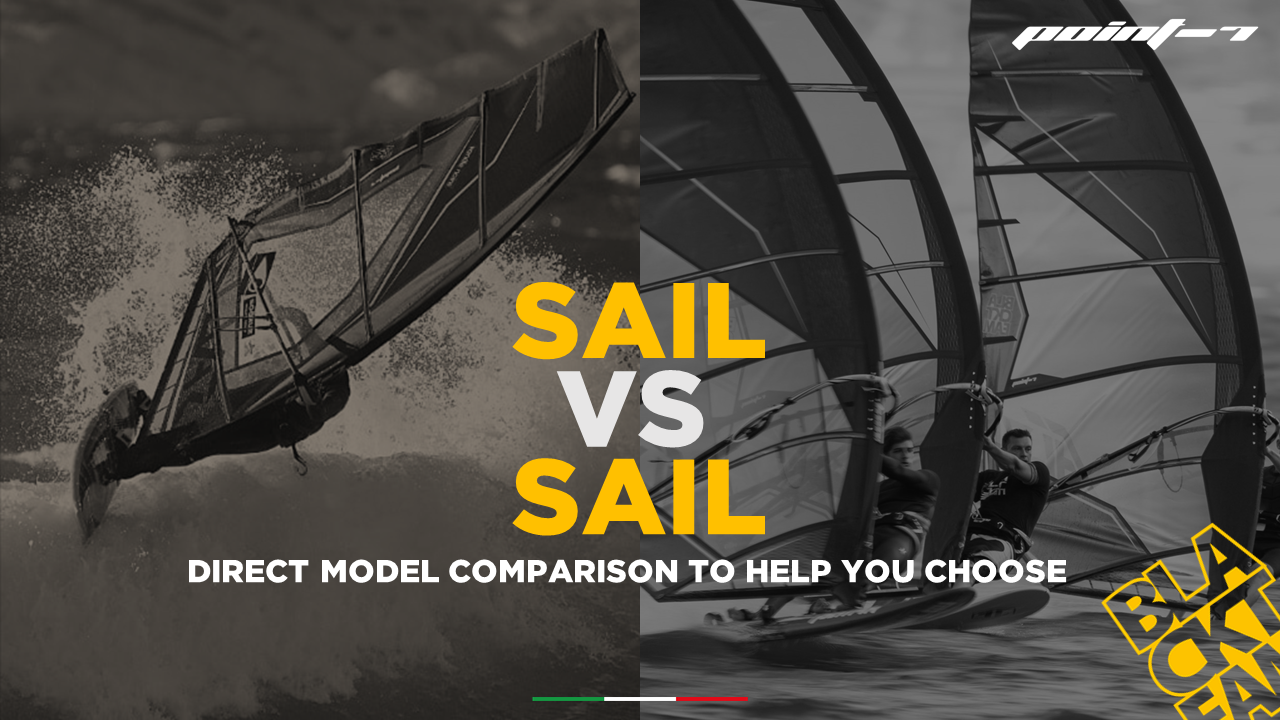
Blog
Sail vs Sail

AC-1 VS AC-Kpro
Bringing the AC-K pro to battle Vs the AC-One, makes the choice to purchase these 2 sails even more difficult. We have made a 2-cam new concept called the AC-Z giving advantages of a no cam sail, and the advantages in performance to be competitive if not stronger than any other any 3 cam sails on the market. For this reason, we could not have a 3 cam at the same level of our 2cam. Therefore, we decided to bring the AC-Kpro to a new level upgrade to be competitive with the any race sails, but to qualify characteristics to be an easier race sail. A sail that would bring you to win races without having the required technical level as a pure racing sail as the AC-1.
Find out from the video the differences between the AC-Kpro and AC-1 »
AC-Z VS AC-Kpro
Isn’t it too much to have a 2 and a 3-cam sail in the range? Well not when you have an AC-Z and an AC-Kpro. Our AC-Z is ready to battle against any other 3cam sails on the market but give the same easy feeling as any other slalom no cam sails, while the AC-Kpro is an easier pure race sail. The end speeds of the sails are the same. The difference is the extra acceleration and power that the Kpro delivers, against a lighter manoeuvrable Z. When you can honestly answer these questions, you can easily choose the right model for yourself. I like to enter some races for fun(Kpro). My jibes are at 70% not on the water, but I rarely plane out of the jibe (Z). I want to just enjoy cambers feeling(Z). I want to make fun of my friends on their full race sails (Kpro).
[/col] [/row] [row style=”collapse” padding=”0px 0px 0 0px”] [col span__sm=”12″ divider=”0″ padding=”0px 0 0px 0px” margin=”0px 0 0px 0px”] [ux_image id=”74533″ image_size=”original” lightbox=”true”]AC-X VS AC-Z
Thanks to us, if once upon a time there was a choice between a no cam sail or a cam sail, now you have also the choice between a no cam sail and the AC-Z, or cam sail and the AC-Z. Cam haters you could find out that you love cams sails, cam lovers… you might start liking the idea of a few cams less!
Let us see how to choose between an AC-X or AC-Z. On the water the 2 sails have a very different feeling. The AC-Z having a deep low profile with the 2 cams below the boom, gives the nice drive that is needed in dodgy conditions of gusty light winds. The pull of the sail is towards the front centre of the sail, which keeps the board easy and balanced over the water, but you need a bit more feeling to use the back-hand power to go upwind. The AC-X has a perfect centred profile, which gives the same pressure on both arms, and it gives an easier back hand power to go upwind. To jibe, both sails are feeling as free as no cams. Jibing the AC-Z feels like not having cams, even if the 2 cams and lower sleeve are as big as the AC-One! The sleeve being this big could bring doubts about the water start, but as it’s only under the boom, to bring out the sail from the water it’s as easy as a no cam. If the cams are rotated to the wrong side, a little bit of technique is needed to turn them. If you really hate cambers in the rigging process, and you really hate even wanting to learn, then the AC-X is the solution, but the AC-Z has an easy wide sleeve at the bottom which gives straight access to the mast to enter in one shot, without having to wrinkle up the sail, but yes you need to learn to put the cams on them mast after having put some downhaul.
If you decide to go for a full set of AC-Z or AC-X that is a good choice as you will have the same feeling for all the sizes. So, if you really do not care of cams, go for the AC-X, and if you like the idea of that extra drive, go for the AC-Z. If you decide to go for a mix, I will certainly go for AC-Z from 7.8 up to 9.4. Therefore, as the wind is light when you use those sizes, or it could be my biggest sail, so for planning and non-planning conditions, the extra lower profile will give me the extra drive to have a higher performance in the gusts or lulls. From 7.57.9 down to smaller sizes, normally the wind is more stable, and this always allows also to a no cam to keep high performance , therefore an AC-X could be the solution.
[/col] [/row] [row style=”collapse” padding=”0px 0px 0 0px”] [col span__sm=”12″ divider=”0″ padding=”0px 0 0px 0px” margin=”0px 0 0px 0px”] [ux_image id=”74534″ image_size=”original” lightbox=”true”]AC-X VS AC-F
Both sails are more friendly oriented sails for slalom as they do not have cams. The AC-F in our case, is the real no compromise manoeuvrable free ride sail in 5.9 and 5.4. It could be the more freeride version of the Spy wave sail, to be used on any freeridefree wave board. You will need to worry about is to enjoy windsurfing. When you get to the 6.4, 6.9 to the 7.5 size, the sail gains a full slalom set up as the AC-X, but with 6 battens and a less extreme low slalom base, instead of full racing low base and 7 battens. If you are looking for a more advanced freeride sail the AC-X can be an interesting sport slalom sail. The AC-X will pull you out from the relaxing side of windsurfing and will welcome you to challenge the surfers who will even be on full slalom race gear, so you need to sail most of the time in full racing stance by closing well the gap and pushing on the fin. The AC-F even if it’s a slalom oriented freeride, is using a more forward profile, demanding less action on your body to cruise and with a lighter feel. The biggest difference of the 2 sails, is that the AC-F being a softer sail due to less luff curve, less battens, more Dacron in the front, will allow to use a size smaller than an AC-X for the same wind range. This way on one side the AC-F will give you a light rig for planning in light wind and right wind range, while the AC-X will give you an endless acceleration, amazing racing speeds for challenging friends on the water and your gps.
[/col] [/row] [row style=”collapse” padding=”0px 0px 0 0px”] [col span__sm=”12″ divider=”0″ padding=”0px 0 0px 0px” margin=”0px 0 0px 0px”] [ux_image id=”74535″ image_size=”original” lightbox=”true”]SALTpro VS SPY
Wave sails are all about style, our sails enjoy any condition with any rider whatever the conditions at a very top level; it’s just to be finding out which one suits your style best! All sails have excellent planning performance. The Spy is all about power, drive and stability. Heavier riders, onshore conditions or even blasting oriented riders will be able to get the most out of this powerhouse sail! Ideal also for bump and jump or simple freestyle moves. The Saltpro, with its super compact outline and 4-batten lay out, is all about manoeuvrability and speed. Profile only on the lower batten, and flat entry on the other battens, good batten rotation around the mast sleeve, will give slightly less power in the rider’s hands and a lighter feel. Compact and dynamic whilst still maintaining drive the Salt is all about taking your moves to the next level of new school wave sailing. The Salt is the perfect wave sail for riders wanting a highly reactive feel. If you are sailing on choppy conditions and onshore often, the Spy will give you what you are looking for. If you are heavy or at the first levels of wave sailing, the grunting drive of the Spy will help you save you from unpleasant conditions, or help you ride a wave thanks to the drive it delivers. The Salt pro will be the sail for the pure wave sailors who want to take their level to the next step, as the sail has no limits. It has taken Ricardo Campello to be Vice World Champion in waves. It can be used also as light fun fast sail to enjoy strong winds.
[/col] [/row] [row style=”collapse” padding=”0px 0px 0 0px”] [col span__sm=”12″ divider=”0″ padding=”0px 0 0px 0px” margin=”0px 0 0px 0px”] [ux_image id=”74536″ image_size=”original” lightbox=”true”]SALTpro VS SLASH
Let’s take the Slash against the Salt. Both have 4 battens. Where is the difference? The Slash has no profile on the battens for throwing the sail straight into the wind without that it changes direction. The Salt has it to have more drive in the bottom turn. The rotation of the battens on the slash is more. This gives a fuller front profile when needing to float after a pop, and therefore have more time to execute a move. The Salt has less to be more reactive and neutral when going for the cut back. The Dacron on the luff panel is wider at the bottom on the Slash to give a faster acceleration in a short space distance, more lower pop power to push higher upwards when jumping. The Dacron on the luff panel of the salt is more focused at the boom height to allow for constant stable power to control the drive either when jumping or riding. The Slash has less loose leach to have more stability and more power in the air and for clew first manoeuvres. The Salt has more lose leach to be more comfortable in a wider variety of conditions, more speed for going for big airs, and to neutralize when finalizing the cut back. The slash has a straight base cut higher for ducking moves. The salt has less to have more power to get planning in super light offshore conditions, and more bottom turn driving power. The base of the Salt has some profile in the base, while the slash stays with the minimum profile needed to give only stability but no power. The Salt has a higher clew and grommet for more comfort while surfing the wave. The Slash lower to easily push up more the base for ducking space. Both will do the job for both freestyle and waves for fun purpose but prioritize your choice according to which of the 2 disciplines you will do the most as they will help improve your skills exponentially.
[/col] [/row] [row style=”collapse” padding=”0px 0px 0 0px”] [col span__sm=”12″ divider=”0″ padding=”0px 0 0px 0px” margin=”0px 0 0px 0px”] [ux_image id=”74537″ image_size=”original” lightbox=”true”]F1e VS AC-LINES
With the introduction of foiling, we have integrated in our range the Foil sail range. We developed dedicated foil sail only for foiling in the racing discipline. The F1 SL and the F1 FW. These 2 models can only be used for foiling as they need to be fully no compromise for pro riders who want to win no matter what!
Regarding the Free race/Freeride foiling we did not want to make a sail only for foiling. As we are not looking to become world champion of foiling in this situation, we decided to make a Hybrid sail for this category. This way those who will choose a Point-7 sail for foiling, they will also be able to use it with normal fin windsurfing, without having to buy another sail of the same size.
There are 2 categories of foiling, and therefore we developed 2 categories of sails for this. For those who will want to go with a freestylewave sail, the F1e 5.4 (liking wave sails in general like Salt or Spy), and for those who want to free race, the F1e 7.6 (liking freerace sails like AC-Z, AC-X).
We choose only one size per sail type. The size had to be the biggest size needed to get planning in the light foil wind, but at the same time if the wind would increase, the sail would keep going for another 8 knots of wind on a board with a fin. Bringing the range of these two sails foiling already from under 10knots, and from over 14 knots on the fin up to around 20knots.
After testing a lot, we did agree that is better to have normal windsurfing sail for freeride foiling in light wind, like the Spy, AC-F, AC-X or AC-Z, and then going on the fin, rather than having a foil sail that would not feel good at all once on a fin, or having to rig another sail to use the fin.
How did we make the sail work to become a Hybrid F1e? It’s not easy to mix the 2, as what would be really needed to make a slalom sail efficient in light wind, is exactly what you would not want to feel on a foil. A foil sail needs to have most of its stiff profile well locked in front. Zero power on the back hand and less opening of leach. While a slalom sail is looking for some backhand power to push on the fin in light wind to get speed and acceleration. A wide outline to generate power, against a shorter boom and high aspect of a foil sail. Wait a second! All those ingredients that a sail needs for light wind on the fin, are though not needed on a foil to go in light wind and are also not needed on a slalom in medium to higher winds! That made the work a bit easier, and by fine tuning the batten set up, profile, outline, opening of the leach we managed to have the sail to perform to have great fun on both fin and foil!
Ideally if you chose a foil sail to go on a fin, it will not bring any fun, but will feel of course good on a foil.
If you take a normal fin sail to go foiling, you could enjoy it only in light wind and not as the first stronger gust picks up, but then will be fun 100% in normal windsurfing conditions from light to strong wind.
If you take our Hybrid sail, you will enjoy foiling in light to medium wind on a foil, and you will enjoy windsurfing on a fin from medium to strong wind. In light wind you could suffer a bit the acceleration.
[/col] [/row] [row style=”collapse” padding=”0px 0px 0 0px”] [col span__sm=”12″ divider=”0″ padding=”0px 0 0px 0px” margin=”0px 0 0px 0px”] [ux_image id=”74812″ image_size=”original” lightbox=”true”]F1e 5.4 Vs Spy 5.4
This is one of the hard ones to choose from.
We developed to the F1e 5.4 to be a new power wave concept in a big size, where most probably 5.4 could be the biggest size needed for the minimum wind. The camber below the boom, the wider sleeve is giving more power and drive, just like if you would be on a 6.0, but at the same time the extra stability helps to blast on windier conditions than normal.
So, our question to you would be: are you ready to believe that this wave sail is the future?
There are 2 answers to this question and the 2 main points are:
-
I sail only in waves and ride them with good energy.
-
I use a wave sail for windy and bumpy conditions and my wave level is more basic?
If you belong to point 1, the decision could be more for having a Spy 5.4. You will be maybe getting into more wipe outs when falling in waves, you would want something more thoughtless from rigging to very quick water starts and trying some more radical rotational moves.
If you belong to point 2, your choice can easily go for the F1e 5.4. You cruise in bump and jump conditions with drive stability and control. Huge wind range and higher and longer jumps. More control on the board. You can still ride waves and try any jumps like back loops and front loops. It’s of course less indicated for moves, where you need a super quick rotation of the tack, but to do that your level is ready for a Slash freestyle or a Salt pro wave batten.
If you like foiling where your 5.9 is normally your biggest sail the 5.4 F1e replace that size immediately. The sail gives the same power and the extra sleeve with and cam is just killing in performance any other wave sail on the foil. The extra is that you can use it without the foil after. The Spy 5.4 is also working on the foil thanks to the nice deep profile in the front, just like foil sails should be, but it does not have the same extra kink as the F1e.
We did not develop the F1e 5.4 for foiling, but after we have been testing it on a foil too, we discovered to be an amazing foil sail, so from being a new concept for wave sailing, bump and jump, we decided to have in our F1e hybrid range!
You are on a lake, or onshore winds spots, sometimes gusty floppy conditions? F1e
Do you wave-sail on a nice side-on spot, sometimes side shore, and you also like a bit more power than a normal wave sail? Spy.
Are we going to see only wave sails like the F1e in the future? We leave this question to those who will get electrified by the new F1 5.4!
Now you can chose!
[/col] [/row]





